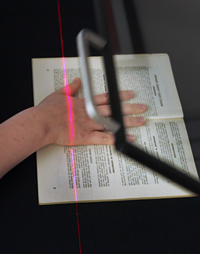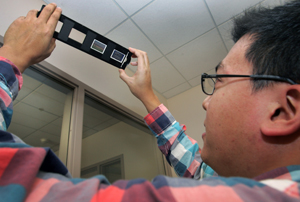 Caption: History graduate student Dani Stephan scans an early course catalog. Photos: Karen Tapia Download photo
Caption: History graduate student Dani Stephan scans an early course catalog. Photos: Karen Tapia Download photo
Documenting the University
Effort Begun to Preserve Historic Documents and Photos
Deep in the offices of the Pollak Library, file folders and boxes contain the history of Cal State Fullerton. Among the folders and boxes? Documents and images that record the campus’s early days of construction and momentous events, along with the daily events that make for a modern university. Then there are the news stories, press releases and various publications, such as course catalogs and athletics media guides, as well as internal documents, that provide the background, additional detail and explanations for the how and why of campus decision-making, and the establishment of programs and departments.
 Caption: Close-up image of a catalog being placed in the scanner.
Caption: Close-up image of a catalog being placed in the scanner.
In the fall, Susan Tschabrun, chair of technical services in the Pollak Library, began the process of scanning and digitally preserving the history of the university. Helping to make it accessible through digitization is Chris Manriquez, associate vice president for information technology.
The duo received a $25,000 Mission and Goals Initiative award to fund the project.
“It is important to not only gather and store material but to make it accessible for faculty, staff, students and the public,” said Tschabrun. “This pilot project is a proof-of-concept study that will allow the university to better understand the costs and benefits of making Cal State Fullerton history more accessible through digitization.
“The goals of the project are several,” Tschabrun noted. “First, we have to identify extant historic publications, documents and images located throughout the university.
“Since 1957, we have produced a variety of historically significant documents that warrant preservation and wider dissemination, including newsletters, course catalogs, athletics media guides, annual reports, commencement programs, presidential speeches, press releases, student association constitutions, photographs and videotapes, just to mention a few.”
While many items are already in the University Archives, Tschabrun said that other collections are located in offices throughout the university. Part of the process, she added, is identifying materials worthy of long-term preservation in University Archives, and from that, a subset has been selected “for digitization based on potential audiences for those materials inside or outside the university.”
Material that has been scanned will receive metadata that will make the material discoverable depending on where the material will be housed.
“For instance, if it is decided that the digital objects should be included in the Online Archive of California, then the metadata formats and controlled vocabulary required or recommended by that repository should be used to describe the objects produced by the digitization project,” said Tschabrun.
Information Technology is assisting the library to acquire the the scanning equipment and server space required to create and store the digital files. Grad assistants and student workers have been tasked with creating the digital scans, adding metadata and placing copies in a “dark” archive dedicated to digital preservation, as well as on publicly accessible servers.
The goal is that the material will be available through several means, such as Dpace, the Online Archive of California, WorldCat and Google, by anyone with an interest in Cal State Fullerton, said Tschabrun.
“Whatever we do, we have to do it right,” said Tschabrun. “It’s not worth doing otherwise.”
 Caption: Susan Tschabrun, chair of technical services, holds a box of early campus slides; behind her, from left, are history graduate student Dani Stephan, Hector Ramirez of Information Technology, history graduate student Mark Sanchez and English graduate student Tara Leederman. Download photo
Caption: Susan Tschabrun, chair of technical services, holds a box of early campus slides; behind her, from left, are history graduate student Dani Stephan, Hector Ramirez of Information Technology, history graduate student Mark Sanchez and English graduate student Tara Leederman. Download photo
Feb. 6, 2012

